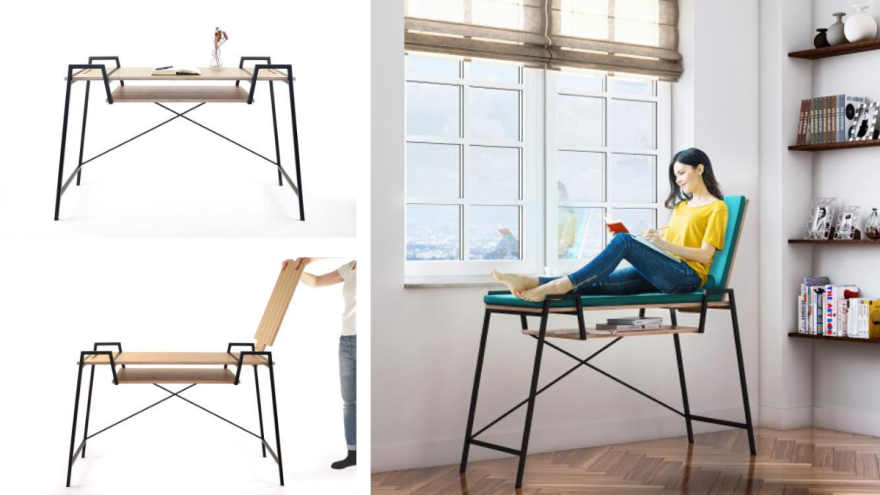Home interiors in transition and new potential
Spiralling rents, overcrowded homes, funding problems – the housing shortage in German metropolises is becoming more and more palpable. A glance at the figures is enough to reveal this: According to Statista , even back in 2019, just 0.8% of homes were unoccupied in Berlin, 0.5% in Hamburg and as little as 0.2% in Frankfurt am Main – and the vacancy rate keeps on falling. A major task for the construction and interior design industries over the coming years will be to make more optimal use of the scarce living space. This can be achieved with modular design.

Adaptivity – the clever way to create new living space
More and more people are moving to the metropolises. And why not? The commutes to work are shorter, the infrastructure makes it easier to balance family and career, and the range of leisure activities in cities is more attractive than in rural regions. But the appeal of living in a central urban location is resulting in overcrowding, and the limited space in these areas is clearly running out. At the same time, continually rising rents are pushing many households to their financial limits.
But the trend for large numbers of people to live in urban environments is also having an impact on the cities themselves: Where overcrowding causes problems, condensed spaces emerge in metropolises. In these inner-city built-up areas, extremely high numbers of people live in a tiny land area, and the volume of traffic is disproportionately high. The negative consequences not only affect the cityscape – they also impinge on the residents’ quality of life.
To tackle these problems, vertical villages offer a good alternative. Alongside apartments, these high-rise buildings provide spaces for interaction, such as communal kitchens or cafes, thereby boosting the sense of community among the residents. Vertical villages break up the cityscape, and by incorporating urban gardening concepts, a closeness to nature can be created. Another way to adapt cities to changing needs is the adaptive reuse of buildings, a concept currently riding high among urban planners and architects. This type of structural measure involves giving the existing space a new or an additional function. The advantages of adaptive construction projects are clear: They remove the need to purchase plots of land as well as the time-consuming construction of an entire new building.
Recognising new opportunities – and seizing them
The adaptive reuse of existing buildings calls for a new type of construction: In modular construction , complete volumetric units are produced in a factory and then assembled at the building site. This offers the benefits of a quick turnaround and the cost-efficient adaptation of existing buildings. Modular micro homes – largely mass-produced homes occupying the smallest possible area – are another way to create economically priced living space quickly.
A groundbreaking example can be found in the United Kingdom: The John Lewis Partnership, which includes the eponymous chain of department stores and the Waitrose supermarkets, is already offering low-price converted homes. This kind of project is also catching on in Germany. For example, a building has been erected on stilts over a car park in Munich, creating 100 new local authority homes and allowing people to live right in the heart of the city despite the housing shortage and overpriced rents. This new type of homebuilding clearly shows what kind of concepts we will need more of in the future. To tackle the housing shortage, existing space must be used multifunctionally or be easily adaptable. Micro homes and modular construction are innovative approaches with enormous potential for further development.

With just two adjustments, the workspace becomes a place of relaxation. (Photo: Movisi GmbH)
Modular design and multifunctional furniture
The problem of limited living space has a ripple effect that now extends beyond architecture and urban planning. Designers and manufacturers are also responding to new requirements – for instance with modular furniture, which customers can adapt to meet their individual needs precisely or even design themselves . The individual modules can be extended in any way imaginable, adapting harmoniously to the living environment. And if the living situation subsequently changes – for example, as the residents grow older – the furniture can easily be reconfigured later. This creates long-term customer loyalty, ensures high customer satisfaction and, quite by the by, saves resources too.
Alongside modular design, demand is also growing for multifunctional furniture that can fulfil diverse needs. After all, if your living space is limited, you long for space-saving miracles: furniture that can be easily and flexibly converted whenever required. Furniture manufacturer Movisi demonstrates what this might look like in practice. The company has developed a desk that transforms into a comfortable window seat with a few quick adjustments. The worktop is simply extended with a backrest, and cushions are supplied for the necessary comfort. In seconds, the home office becomes a place of relaxation.
Multifunctional furniture is often more expensive to produce and purchase. But consumers are willing to make this investment. Private household expenditure on interior design has been rising for years.
Modular design: the path to a successful future
When designing modular, multifunctional furniture, ideally every age group should be taken into consideration. Demand isn’t high just among young, trend-conscious customers. Driven by demographic change, the over-50 target group with its strong purchasing power is growing, and so, too, is the desire for intelligent interior solutions.
Anyone looking at the evolution of our metropolises and people’s needs will find many opportunities to respond to them with adaptive concepts – and thereby open up new business potential. Don’t miss out on valuable inspiration from imm cologne and the advantage it gives you. Subscribe to our magazine newsletter now to stay up to date .
